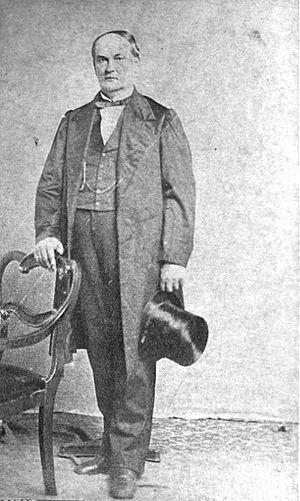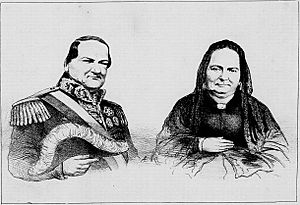Carlos Antonio López facts for kids
Quick facts for kids
Carlos Antonio López
|
|
|---|---|
 |
|
| 1st President of Paraguay | |
| In office March 13, 1844 – September 10, 1862 |
|
| Vice President | Mariano González (1845–1846) Francisco Solano López (1862) |
| Preceded by | himself as Consul |
| Succeeded by | Francisco Solano López |
| Consul of Paraguay | |
| In office March 12, 1841 – March 13, 1844 |
|
| Preceded by | Mariano Roque Alonso |
| Succeeded by | himself as President |
| Personal details | |
| Born | November 4, 1792 Asunción, Paraguay, Viceroyalty of the Río de la Plata, Spanish Empire |
| Died | September 10, 1862 (aged 69) Asunción, Paraguay |
| Political party | None |
| Spouse | Juana Pabla Carrillo |
| Children | Francisco Venancio Benigno Rafaela Inocencia |
Carlos Antonio López Ynsfrán (born November 4, 1792 – died September 10, 1862) was an important leader of Paraguay. He guided the country from 1841 until his death in 1862. He is known for helping Paraguay become truly independent and for making many improvements.
Early Life and Challenges
Carlos Antonio López was born in Manorá (Asunción), Paraguay, on November 4, 1792. He was one of eight children. He studied at the Real Colegio y Seminario de San Carlos. After finishing school, he became a lawyer. This job helped him meet many important people.
However, he faced problems with the country's previous leader, José Gaspar Rodríguez de Francia. Francia was a very strict ruler, sometimes called a dictator. Because of this, López had to hide for several years to stay safe.
Becoming a Leader
After Francia died in 1840, Paraguay needed new leaders. López briefly worked as a secretary for the group that ruled the country. This group was led by Colonel Mariano Roque Alonzo.
In March 1841, the country's Congress chose López and Alonso to be joint leaders, called consuls, for three years. A consul is like a top official who shares power. By 1844, López became the sole leader. He then took on more power to guide the country.
A few months later, Congress created a new set of rules for the country, like a constitution. This document changed the leader's title from consul to president. López was then elected as the first president for a 10-year term. This new constitution gave him a lot of power, similar to what the previous ruler had. However, it did not include rules to protect people's rights.
López was re-elected president several times. He served another three-year term starting in 1854. Then, in 1857, he was elected for ten more years. He even had the power to choose who would take over after him.
Developing Paraguay
President López worked hard to make Paraguay stronger and more modern.
- Building the Economy: He focused on using Paraguay's natural resources. He hired many experts from other countries, especially England. These experts helped build new things and improve the country.
- Strong Defenses: He built a very strong fort called the Fortress of Humaitá. This fort helped protect Paraguay.
- Recognizing Independence: Before López became president, Paraguay did not have an official document saying it was a free country. López helped Paraguay gain recognition as an independent nation from other countries.
- Foreign Relations: He had some disagreements with other powerful nations like the Empire of Brazil, the United States, and the British Empire. These disagreements sometimes almost led to war.
- More Freedom: López's government was more open than the previous one. He released all political prisoners soon after he took full power. He also took steps to end slavery in Paraguay.
- Economic Growth: During his time as president, Paraguay's economy grew a lot. He signed trade agreements with Brazil in 1850, and with Great Britain, France, and the United States in 1853. He also signed one with Argentina in 1856.
- Better Infrastructure: His government improved roads and transportation. They built a new railroad line and started steamship routes on rivers.
- Education: López also cared about education. He expanded primary schools and reopened the seminary where he had studied. This helped more people learn to read and write.
After Carlos Antonio López died, his oldest son, Francisco Solano López, became the next president. Today, a neighborhood in Asunción is named after him, called Carlos A. López.
See also
 In Spanish: Carlos Antonio López para niños
In Spanish: Carlos Antonio López para niños
| Political offices | ||
|---|---|---|
| Preceded by Mariano Roque Alonso |
Consul of Paraguay 1841–1844 |
Succeeded by himself as President |
| Preceded by himself as Consul |
President of Paraguay 1844–1862 |
Succeeded by Francisco Solano López |


